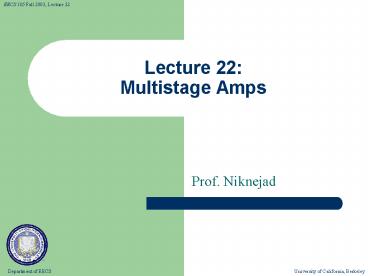Lecture 22: Multistage Amps
1 / 33
Title: Lecture 22: Multistage Amps
1
Lecture 22Multistage Amps
- Prof. Niknejad
2
Lecture Outline
- Finish Current Mirrors
- An Example Using Cascodes
- Multistage Amps
- Cascode Amplifier Magic!
3
The Integrated Current Mirror
- M1 and M2 have the same VGS
- If we neglect CLM (?0), then the drain currents
are equal - Since ? is small, the currents will nearly mirror
one another even if Vout is not equal to VGS1 - We say that the current IREF is mirrored into
iOUT - Notice that the mirror works for small and large
signals!
High Res
Low Resis
4
Current Mirror as Current Source
- The output current of M2 is only weakly dependent
on vOUT due to high output resistance of FET - M2 acts like a current source to the rest of the
circuit
5
Small-Signal Resistance of I-Source
6
Improved Current Sources
Goal increase roc
Approach look at amplifier output resistance
results to see topologies that boost resistance
Looks like the output impedance of a
common-source amplifier with source degeneration
7
Effect of Source Degeneration
- Equivalent resistance loading gate is dominated
by the diode resistance assume this is a small
impedance - Output impedance is boosted by factor
8
Cascode (or Stacked) Current Source
Insight VGS2 constant AND VDS2 constant
Small-Signal Resistance roc
9
Drawback of Cascode I-Source
Minimum output voltage to keep both transistors
in saturation
10
Current Sinks and Sources
Sink output current goes to ground
Source output current comes from
voltage supply
11
Current Mirrors
Idea we only need one reference current to set
up all the current sources and sinks needed for a
multistage amplifier.
12
Multistage Amplifiers
- Necessary to meet typical specifications for any
of the 4 types - We have 2 flavors (NMOS, PMOS) of CS, CG, and CD
and the npn versions of CE, CB, and CC (for a
BiCMOS process) - What are the constraints?
- Input/output resistance matching
- DC coupling (no passive elements to block the
signal)
13
Summary of Cascaded Amplifiers
- General goals
- Boost the gain parameter (except for buffers)
- Optimize the input and output resistances
Rin Rout
Voltage
Current
Transconductance
Transresistance
14
Start Two-Stage Voltage Amplifier
- Use two-port models to explore whether the
combination works
CE1,2
Results of new 2-port Rin Rin1, Rout Rout2
15
Add a Third Stage CC
Goal reduce the output resistance (important
spec. for a voltage amp)
CE2
CC3
CE1
Output resistance
16
Using CMOS Stages
CS2
CD3
CS1
Input resistance
Voltage gain (2-port parameter)
Output resistance
17
Multistage Current Buffers
Are two cascaded common-base stages better than
one?
Input resistance Rin Rin1
18
Two-Port Models
Output impedance of stage 1 (large)
19
Common-Gate 2nd Stage
20
Second Design Issue DC Coupling
Constraint large inductors and capacitors are
not available
Output of one stage is directly connected to the
input of the next stage ? must consider DC levels
why?
3.2V
21
Alternative CG-CC Cascade
Use a PMOS CD Stage DC level shifts upward
3.2V
22
CG Cascade DC Biasing
Two stages can have different supply currents
Extreme case IBIAS2 0 A
23
CG Cascade Sharing a Supply
First stage has no currentsupply of its own ?
its outputresistance is modified
24
The Cascode Configuration
Common source / common gatecascade is one
version of a cascode (all have shared supplies)
DC bias Two-port model first stage has
no current supply of its own
25
Cascode Two-Port Model
Output resistance of first stage
Why is the cascode such an important
configuration?
26
Miller Capacitance of Input Stage
Find the Miller capacitance for Cgd1
Input resistance to common-gatesecond stage is
low ? gain acrossCgd1 is small.
27
Two-Port Model with Capacitors
Miller capacitance
28
Generating Multiple DC Voltages
Stack-up diode-connected MOSFETs or BJTs and run
a reference current through them ? pick off
voltages from gates or bases as references
29
Multistage Amplifier Design Examples
Start with basic two-stage transconductance
amplifier
Why do this combination?
30
Two-Stage Amplifier Topology
Direct DC connection use NMOS then PMOS
31
Current Supply Design
Assume that the reference is a sink set by a
resistor Must mirror the reference current and
generate a sink for iSUP 2
32
Use Basic Current Supplies
33
Complete Amplifier Topology
Whats missing? The device dimensions and the
bias voltage and reference resistor































